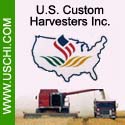 |
 |

|
|
|
Minnesota Ag News Headlines |
 |
Squirrels of the Whitewater Valley
Minnesota Ag Connection - 02/12/2016
Ryan Tebo pulls over to the side of the road to fiddle with the knobs on a small radio receiver propped up in the center console of the truck he's been piloting slowly through the wooded hillsides along State Highway 74 in Winona County. Adjusting the volume
as he changes frequencies, Tebo, a wildlife research biologist with the Minnesota Department of Natural Resources, isn't looking for any particular genre of music, though; you might say he's trying to tune in a little squirrel talk radio.
Out in the woods and wetlands of the Whitewater River valley, a select group of the bushy-tailed rodents are sporting radio transmitters aimed at answering a question: Does hunting pressure on public lands have a significant effect on squirrel populations? It's a
question that began cropping up several years ago based on reports that hunters weren't seeing as many squirrels on heavily used units such as Carlos Avery Wildlife Management Area (WMA) in the north metro area and Whitewater WMA, two hours
southeast of the Twin Cities. Were too many squirrels being harvested? Did bag limits need to be adjusted? To answer them, wildlife managers turned to the DNR's Farmland Population and Research Group in Madelia.
Marrett Grund, the group's leader, knows a thing or two about hunting in relation to wildlife populations. He's spearheaded the research and modeling on which deer seasons are based in both Minnesota and Pennsylvania. When he investigated to see what other
research had been done around "squirrel harvest mortality" -- the scientific phrase for the number of squirrels taken by hunters -- there wasn't a lot to look at.
Ready to chart some new territory, Grund's research group designed a study where two groups of squirrels would be fitted with radio collars: one where hunting is allowed, the other in a nearby area where hunting is prohibited. The Whitewater valley, with a
wildlife management area open to public hunting and an adjacent state park that's not, seemed perfect. The research would compare the number of squirrels that die in the park, where only natural causes of death are at play, with the number that die in the
WMA, where some are harvested.
All that remained was to persuade 100 squirrels to volunteer for the privilege of sporting some fancy neckwear in the name of science. Grund and Tebo started setting small live traps in mid-July, baiting them with seeds and corn as recommended by colleagues.
The squirrels didn't bite. At the suggestion of people with experience trapping squirrels in urban areas, the researchers switched to peanut butter, but it turned out the squirrels had no interest (although the chipmunks and raccoons weren't so fussy). The
researchers tried placing the traps on platforms, but the trapping didn't improve. By the first of September, they had managed to outfit only 20 squirrels, with the small game hunting season -- when the study was supposed to start -- less than three weeks away.
Tebo found a moment of inspiration at a St. Charles motel where he was staying. Hearing a commotion outside his window, he looked out upon squirrels chattering crazily and scrambling around the branches of a large tree, all carrying green walnuts. Although it
seemed a little early, it looked like the squirrels were already stockpiling nuts for the winter. Tebo picked up some walnuts and tried baiting a few traps -- success at last! Over the next couple weeks, 80 squirrels showed up in the traps (and zero chipmunks).
"The squirrels at the motel provided a guiding light," Tebo recalls. "Fortunately the motel owner was nice and let me pick up all his walnuts."
Traps were set before dawn, then checked mid-morning and again at dusk. Upon approaching a trap with a squirrel in it, the cage first is covered with a large cloth to settle the animal. Researchers weigh the trap with the squirrel in it, look over the animal quickly
to determine its sex, then insert one end of the cage into a large denim funnel or handling cone. When the door is opened, the squirrel runs toward the narrow end of the funnel, where it's restrained with fabric straps, then the cloth funnel is unzipped a few inches,
exposing the animal's head and neck. Another small plastic cone is wrapped around the squirrel's head to prevent it from biting its handler, and then the transmitter is attached around the squirrel's neck -- basically a zip-tie with a thumbnail size bulge. Total
average time in the handling cone: a couple minutes.
"Then you unzip the funnel and they shoot out of there like a rocket ship," Tebo said. "You have to be quick, because we really don't want to stress them out."
For the first few weeks after the opening of the small game hunting season, Tebo would check on the squirrels twice a week; later on, status checks were cut to once weekly because most squirrel hunting occurs in the first few weeks after the opener. Each
squirrel's transmitter has a discrete frequency that broadcasts a chirping sound about once every two seconds. If a squirrel is killed or remains motionless for another reason longer than 24 hours, the rate of the chirping increases to once a second.
Tebo drives around the park and WMA listening for chirps on the different frequencies, trying to log the status of each animal weekly. The radio collar for one squirrel has gone into "mortality mode." Tebo parks his truck near the south entrance to Whitewater
State Park and retrieves what looks like a small television antenna from the back of the truck. He plugs it into his handheld scanner and, after waving it back and forth a few times to get a general bearing on the transmitter, slowly starts up a steep wooded
hillside. Zigging a little to the left, and then zagging a bit to the right, Tebo zeroes in on a large old oak tree. He pokes around among the leaves at the base of the tree and finds several bits of squirrel fur, but no collar. After scrutinizing ground and tree for a good
10 minutes, he concludes that it's likely up in the tree, left there after an owl's squirrel lunch.
As of late December, about a quarter of the radio-collared squirrels could be identified as still being active on the WMA, whereas about three-quarters of the radio-collared squirrels were still active in the state park. These figures are considered preliminary
because squirrels use tree cavities in winter, making it more difficult to detect the radio signals. But Grund and Tebo are confident that at least half of the radio-collared squirrels on the WMA were harvested by hunters. Does that mean that hunting results in
fewer squirrels in the woods over the long-term? Not necessarily, Grund says, because other factors come into play as well. For instance, spring reproduction increases in some small game populations due to decreased competition after fall hunting reduces
numbers. In other words, nature compensates to keep populations stable. Further study and analysis will be needed to determine if long-term squirrel populations are affected by the existing hunting season format.
The researchers plan to continue monitoring the remaining collared squirrels until the end of squirrel season, which runs through Feb. 29. Next summer, another 100 squirrels will be trapped and collared for the second phase of the project. Some of last year's
squirrels may continue to be monitored also, as transmitters on the collars can go nine months or more before the batteries die.
"Our goal with squirrels, as with any game species, is to maximize recreational opportunities for Minnesota hunters, while maintaining healthy populations," Grund says. "This study will provide the scientific information needed to decide how well our rules and
regulations are working toward those ends."
Other Minnesota Headlines
|
|
 |


|
 |
|
Copyright © 2024 - Farms.com. All Rights Reserved. |
 |
|